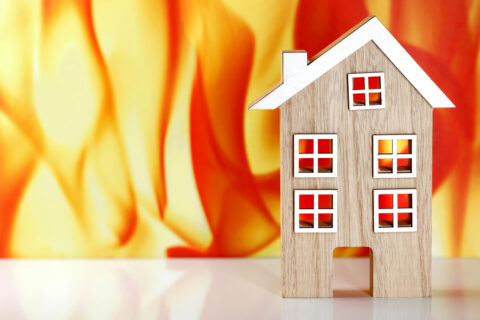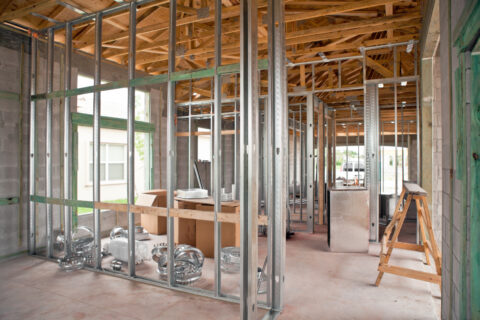
When a fire burns at your home or business, what you are able to salvage from fire damage will depend on what the structure and its contents are made of. Here’s how fires at your home or business may affect common materials.
How Fire Affects the House Structure
Modern buildings can be made of many different materials, too many to consider here individually. We’ll look at some of the more common materials used in construction and how they might fare during a typical fire in a house or business.
Wood
Wood is the most common building material for homes and many commercial buildings as well. Wood is highly susceptible to fires. It will catch fire at typical house fire temperatures, causing the fire to spread its destruction. In addition, even wood that doesn’t burn can be significantly damaged by fire. Exposure to high temperatures can cause wood to weaken, becoming more brittle.
Metal

The heat of a fire can cause steel to expand, which can lead to structural damage around the steel framing. The heat could also cause the steel to soften, which will allow it to sag and deform under the weight it is supposed to support. Sometimes, the heat might cause no visible damage to the steel, but heat exposure might change its properties, making it weaker, more brittle, or more flexible.
Concrete
Concrete is a durable material, and it’s highly resistant to fire. Concrete won’t burn, and although it can acquire dark stains from smoke and suit exposure, it cleans off well.
However, concrete can be damaged by fire. At temperatures common in structure fires, concrete can lose its strength, leading to immediate or delayed failure. Concrete walls exposed to prolonged heat should be examined for potential changes in its properties.
Drywall and Plaster
Drywall and plaster are relatively fire-resistant materials, but they aren’t completely fireproof. Both drywall and plaster can burn in fires at common structural fire temperatures. However, the material can slow a fire until either the paper of drywall or wood lathe of plaster burn away.
How Fire Affects House Contents
Fire will tear through a building, consuming the contents as well as the structural materials. However, not all materials will be destroyed by fire. Here are some of the materials you can expect to be consumed or destroyed in a fire.
Consumables: Cloth, Wood, Paper, and Plastic

Precious Metals
Precious metals have melting points within the range of typical structure fires. Those closest to the fire are most likely to melt. Thin chains are also most likely to melt. However, larger, thicker objects that aren’t near the hottest parts of the fire are more likely to survive.
Ceramics
Ceramics are generally highly durable from the effects of heat. Most ceramics are fired at temperatures above those reached by typical structure fires, so they can get through a fire without burning or melting.
However, ceramics are vulnerable to sudden changes in temperature, which can make them shatter. A rapidly spreading fire can cause ceramics to explode from the sudden heat change. Those that survive heating to the fire temperature, though, can explode when touched by cold water used to douse the flame. They can also shatter when the wood shelves or hutch supporting them burns, allowing them to fall.
Glass
Glass doesn’t melt like other materials because it’s already a liquid at room temperature. However, when glass heats, it becomes more likely to flow, which can cause glass to lose its desired shape. In addition, it can shatter in similar ways that ceramics can.
Steel
As with structural steel, steel contents of your home like tools and appliances might survive a fire. However, even if they’re not destroyed, these appliances can be damaged. They might warp and change their properties. Hardened tool steel, for example, can become soft and malleable. In addition, handles, knobs, wiring, and other essential parts of tools and appliances that aren’t made of steel can burn away, making objects unusable.
Help with Fire-Damaged Structures and Contents in the greater Seattle & Spokane Metro Area
Fire is one of the most destructive disasters that can strike your home or business. When it burns a building, almost everything in the building will be burned, warped, weakened, or contaminated.
However, that doesn’t mean that nothing can be saved. At Just Right Cleaning & Construction, we’ve been helping families and businesses recover from fires in the greater Seattle & Spokane Metro Area since 1954. We can help you, too.
We offer 24/7 emergency response services, so our experts can arrive at your home or business soon after the fire is extinguished. They can perform every step in the fire damage restoration process, including an initial safety inspection, board-up service, and the final touches to help your house look like new again. We can even perform smoke damage restoration of contents like electronics, clothes, and upholstery.
Plus, JRCC Damage Restoration Experts can work directly with your insurance company, documenting all the damage and the repairs to ensure you get paid according to the terms of your coverage, with no reductions or delays because the claim wasn’t filed properly.
To learn how JRCC Damage Restoration Experts can help you, please contact us at 844-967-4911 today. We serve customers in the greater Seattle & Spokane Metro Area.
